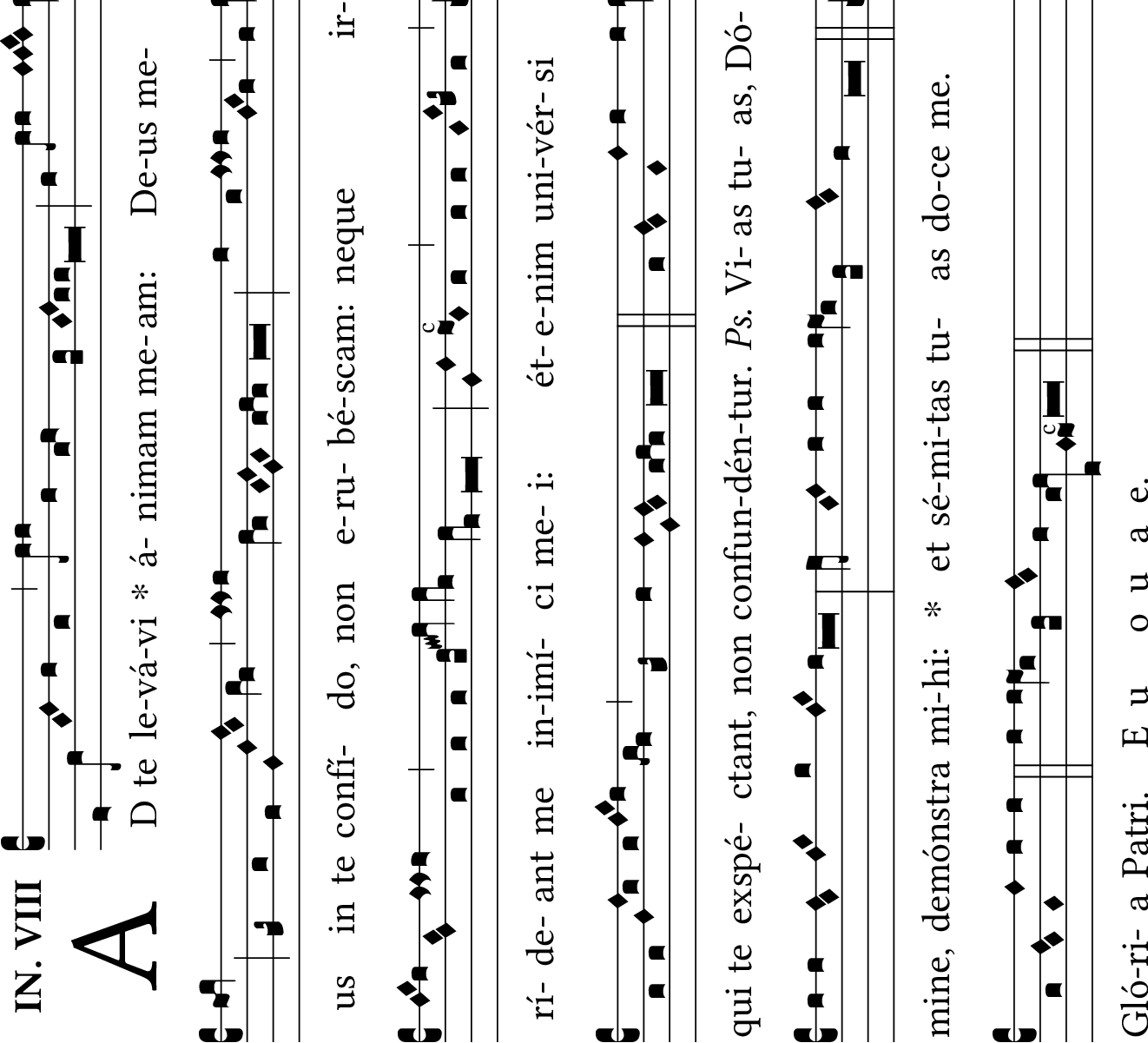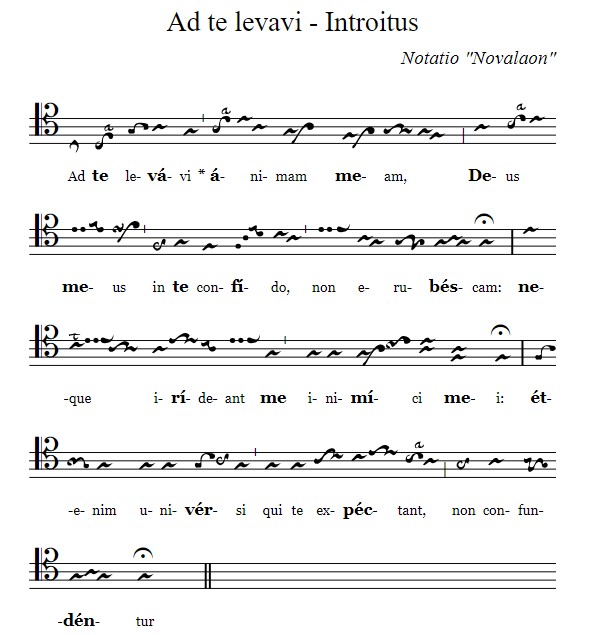My thoughts on chant rhythm (and a few other things)
-
This is a fascinating discussion. I have my own quite strong opinions on how Chant ought to be sung, but acknowledge that it is impossible to know exactly how chant would have been sung in earlier centuries, and therefore don't fault anyone else for holding an opinion different than mine. Mine stems mostly from what I grew up with and studied in college, sang for 2 years in a monastery, and have continued to stick with, but I also acknowledge that other "methods," if you can even call them a method, can also be beautiful.
On the one hand, there have always been local traditions, and variances from location to location in the liturgy, and I am sure this has always been reflected in the music from location to location or region to region as well. On the other hand, it's really unfortunate that chant performance in the liturgy is a somewhat divisive topic with many differing opinions. And the reason it is really unfortunate is that the liturgy itself has suffered very, very greatly in the past 60 years, with the advent of the Novus Ordo Missae and its countless options (most of them non-traditional options, but that's not my point here...) - the last thing we need in today's Church is yet another point of disagreement and seeming lack of unity. For decades now (particularly the decades leading to Vatican II) the liturgy has been subject to so much criticism and change supposedly based on early sources, and it seems that in many ways the same has happened with Gregorian chant.
My view on the liturgy is that we really just need to go back to the pre-Vatican II liturgy, and until we live in more sane times, we should just learn to love the liturgy as it developed until then. After the Church (and the world) comes more out of its current crisis, maybe then we'll be able to take a good, better, more honest look at "reforming" the liturgy (although I personally think there is little to no reforming necessary of a liturgy that has developed from Apostolic times into what it was before the reforms of the '60s). I tend to think the same about chant, but it's a little more difficult to pinpoint what "method" would be the most likely for the Church (Latin church at least) as a whole to agree upon and stick with until more sane times. -
@charlessa
That is very beautifully said and well put. I share the same sentiments. I think the whole world is going to go far beyond what I would term a rude awakening in the coming year -
According to Dom Jean Claire, who was at Cardine's bedside at the time of his death and and to whom Cardine dictated his "Final Testament," Cardine held that the difference between the value of a "long" note and a "regular" note was the difference between the time it takes to pronounce a syllable the consists of a vowel plus consonant and a syllable that consists of a vowel only. Claire urged that chant directors should recruit someone to record this difference and show singers how short it is. Cardine never approved of any recorded performance purpotedly based on his teachings.
Cardine recognized that incorporating all the nuances shown in the adiastematic mss. according to his interpretation was nigh unto impossible and discouraged the attempt except in ideal circumstances.
We need not agree with Cardine 's ideas about note values or anything else; but those who claim to perform "according to the teachings of Cardine" should either embrace his reported ideas or drop their claim.
In the Liber hymnarius Solesmes attempted to show all the nuances evident in the adiastematicmanuscripts. Choirs (monastic choirs, probably) complained that singers were doubling every note marked with an episema, with ludicrous results. So in subsequent recent books Solesmes stopped including the episemas.
My source for what I've written about Claire's statements is, Jean Claire, “Dom Eugene Cardine (1905-1988)" Revue gregorienne XVII (1989), 20. -
Although Anthony Ruff, no fan of Dom Mocquereau’s signs, has observed that Solesmes observes them in an oral tradition and the choirmaster of Saint-Benoît-du-Lac added them to the modern antiphonal by hand… and Solesmes then revised the preface to the Liber Hymnarius, but, some would argue, since they want to do away with the signs, they’ve taken away the clues.
In a comment, a reader mentions the Praglia antiphonal, which does make use of rhythmic signs. Interesting, and apparently there is a Benedictine monastery of nuns in Rome that uses this book, in addition to the monasteries that produced it. So there you are. -

I would do the notation like this: in melismas - short in sixteenth notes, long in eighth notes; outside of melismas - stemless black note head for long/syllabic time and sixteenth note for short. Some "tenuto" indicating expressive slowing chosen by me as an expressive nuance, an accent notation ">" indicating on a note an important crescendo in intensity and "ictus" marks marking some important downbeats to maintain an interesting flow.
the notation could be interpreted in a nuanced semiological style by considering the distinctions between long and short as not strictly proportional and using "rubato".
 test notation.jpg517 x 113 - 17K
test notation.jpg517 x 113 - 17K -
The "quarter bar" and the ligatures maybe could be used to separate the neumatic elements of the long melisma instead of grouping section of phrases. Or the long melisma could be represented by a ligature and the beaming of the eighth and sixteenth notes would separate the neumatic elements.
Thanked by 1OMagnumMysterium -
Maybe in the future I could spent time writing in this syle of modern notation using the edition of Patrick as a guide to where is long, where is short, where is grace, etc.Thanked by 1OMagnumMysterium
-
I can easily add stropha, oriscus and quilisma

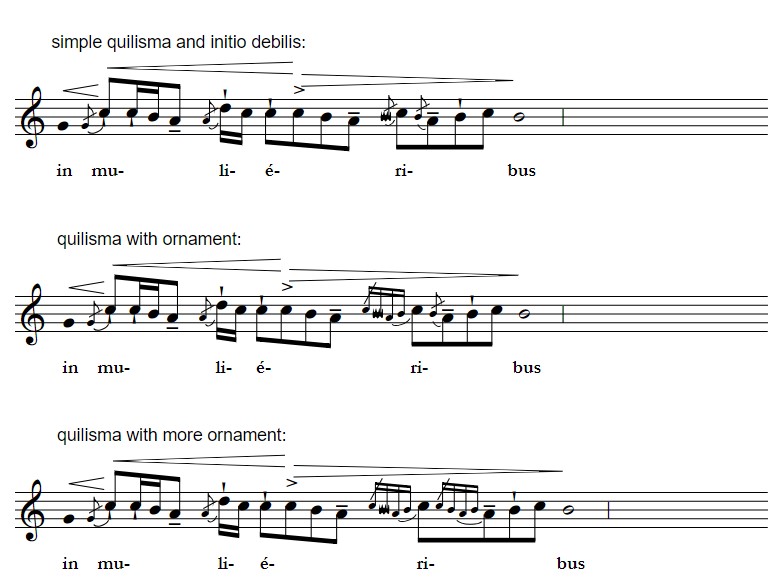
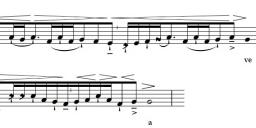
 test notation 1.jpg785 x 284 - 43K
test notation 1.jpg785 x 284 - 43K
 test notation 2.jpg784 x 582 - 80K
test notation 2.jpg784 x 582 - 80K -
To Lincoln_Hein:
When I wrote something similar, people complained that it's too ornate and quoted "tra la sollicitudine" against me.
My version of Ave Maria is still on the first page of this thread -
Check out the pdf and tell what you think.
I could do something like this for the entire gradual.

 teste ad te.pdf141K
teste ad te.pdf141K -
I think that sort of notation does a good job explaining proportional rhythm, at least visually and intellectually, but in practice I would have a very hard time singing from it, unless someone helped me learn it and I practiced more. I think that Mr. Williams' editions are easier for me to sing from, but this notation definitely has some interesting ideas as well.
I like how the three different colors are used, and I think if the neumes are included, it should be like this. I think the neumes would be beneficial in an earlier edition to teach people about where the proportional rhythm comes from and for people who read the neumes to compare for themselves, but in a final performing edition, they should be left out. Whatever notation is used should convey all the information of pitch and rhythm without having to include two other notations in the same score.
I would really like to see a notation which has the horizontal compactness of Mr. Williams' editions which comes from use of the podatus, but without using the episema for every single long note. If someone could design a notation, it could be made into a gregorio font in FontForge, and then it could be used with gabc.
I also think four staff lines are adequate and easier to read than five, and the traditional Do clef is preferable over the treble clef. -
OMagnumMysterium, given your preference for a traditional square-note notation that could express both pitch and rhythm, are you familiar with the Graduale Renovatum project?
www.GradualeRenovatum.com
Thanked by 1FSSPmusic -
I link to the Graduale Renovatum on my page and find it to be an interesting edition. The most frequent criticism of my editions is that they are too cluttered with episemata. In the Ad te introit, the Graduale Renovatum shows the same rhythm at (ne)que and (exspe)ctant, apparently short-long-long, which cannot be justified from the triplex edition. The rhythm at the end of -que is short according to Laon or long according to St. Gall 376; I see no justification in those two manuscripts for short-long-long. At -ctant, why not use the initio debilis figure to notate what Cardine calls the special torculus?
-
I am familiar with the Graduale Renovatum. It seems obvious to me though that the Graduale Renovatum does not show strict proportional rhythm. I suppose there are two questions here, that of what the "authentic" rhythm and melody is, and how it is most effectively notated. I'm really only considering the second question at the moment. Following the sort of pluralism which Dr. Weaver often advocates for, I would be interested to improve the notation of all schools of rhythm, just to be able to have an easier time of singing each of them if nothing else.
For proportional rhythm, I have not found any notation I have seen completely satisfying as being both elegant and effective. But I readily admit I may not be the best judge, both due to my perfectionism, and my bias towards the types of notation I am most used to and enjoy singing and looking at.
If you have a collection of recordings, Mr. Nickel, I would be interested to listen to some while following along with your editions to get a better idea of what you're really aiming at. Our schola director follows a roughly semiological approach while singing from the Liber (formerly he used the Triplex). It used to frustrate me, but I've gotten used to it over the years, and I've started to appreciate the expressiveness of certain parts of his method.Thanked by 1CHGiffen -
I second OMagnumMysterium's request for a few recordings of the Renovatum editions. I have followed the Renovatum project for a while now, and would love to hear Royce's own interpretations of it. Thanks!Thanked by 1CHGiffen
-
I don't mean to speak for Royce, but I'm pretty sure his edition is intended to convey mainstream semiology, such as Göschl's:
https://www.youtube.com/watch?v=mStjSU36Ceo -
I can easily use four lines and "Do clef" with modern notes if this helps.
In a square notation I think it would be easier not to mark the long notes but to mark the short ones. It would be good if someone made a stylized "c" (for "celeriter") for the greogorio/gabc and of a reasonable size that could be placed above or below the short notes instead of putting an episema on the long ones.
Thanked by 1OMagnumMysterium -
An option would be use "diamond shaped punctum" in all breves.


 test diamond.jpg646 x 209 - 31KThanked by 1OMagnumMysterium
test diamond.jpg646 x 209 - 31KThanked by 1OMagnumMysterium -
That's vert similar to what I was about to post!
I think my ideal preference for notation of proportional rhythm would be the following:
Punctum for long
Diamond for short
Tiny liquescent or mini diamond for extra short/grace notes
Dotted punctum for long and a half? (like modern notation)
Punctum with episema for double long
But then perhaps short notes can still be connected with bars to aid legibility of neume groupings. It's a work in progress, but here is what I've been putting together the last few hours: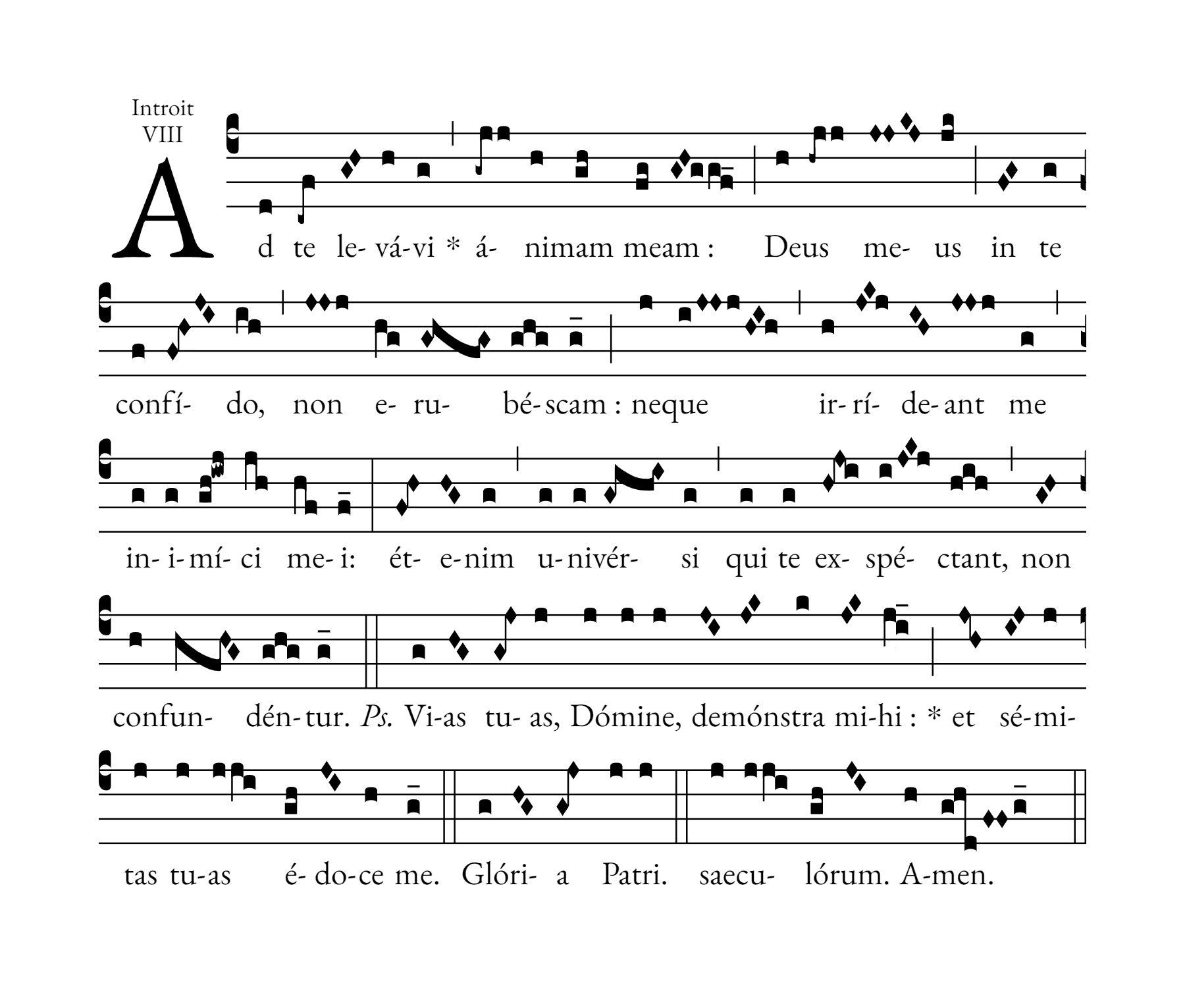

 Ad Te Levavi proposed notation.png1800 x 1531 - 159K
Ad Te Levavi proposed notation.png1800 x 1531 - 159K -
Here's a rough draft of how very basic neumes might be constructed. I'm not completely sure about the short clivis and pes one step apart. I also just realized I forgot the porrectus. I'll fiddle around a bit more.

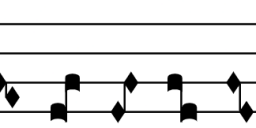
 Neumes Draft 1.png1122 x 162 - 12K
Neumes Draft 1.png1122 x 162 - 12K -
another option is similar to "fluxus notation" but with Laon neumes corrected in some places (here I put the two pes initio debilis indicated by st gall.):

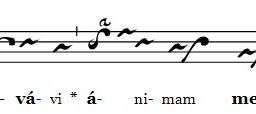
 test laon_on_stave.jpg553 x 114 - 14K
test laon_on_stave.jpg553 x 114 - 14K -
My fundamental problem with the extensive use of the diamond/rhombus/punctum inclinatum is that it introduces and necessitates a non-cursive form of figures that were historically cursive, e.g. the short pes, clivis, and torculus. How will you notate a long climacus? How will you notate an initio debilis before a short clivis? As for liquescents, no one is likely to misinterpret the cephalicus or epiphonus as two longs, but what about the short form of the pinnosa? This is entirely legible at sight—but so is my usual edition ;)
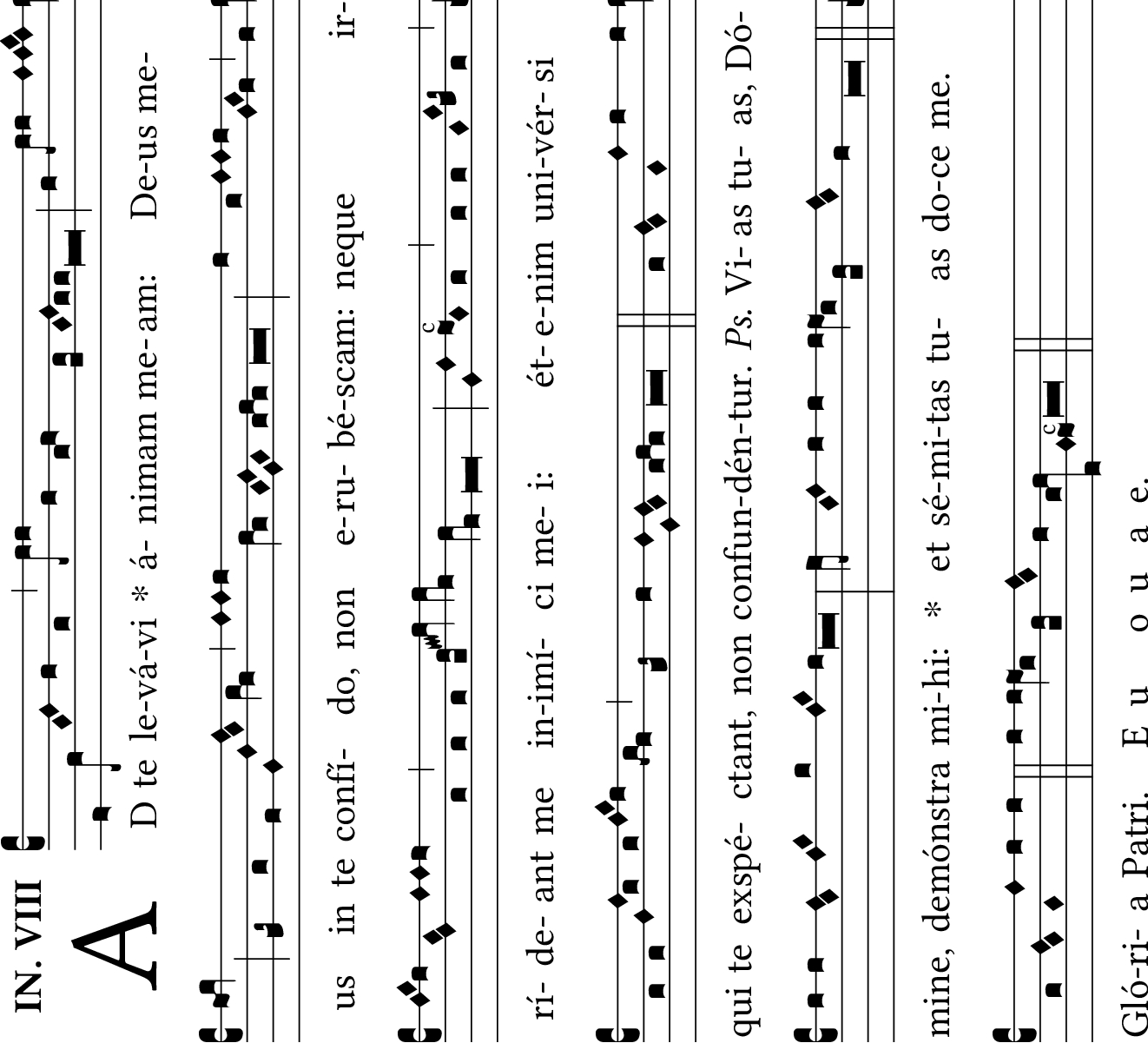
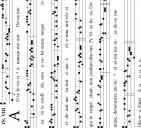
 In Ad te levavi.jpg1322 x 1201 - 392K
In Ad te levavi.jpg1322 x 1201 - 392K
 In 8 Ad te levavi.jpg1322 x 1201 - 398KThanked by 1Lincoln_Hein
In 8 Ad te levavi.jpg1322 x 1201 - 398KThanked by 1Lincoln_Hein -
I prefer this last notation you posted here Patrick than the usual with all those visually unkward episemas.
-
I'm not a fan of "Novalaon" style. It's not very good at depicting the pitches of some of the notes; one still needs to have a prior knowledge of the melody to use it. At least that is how it sounds to me.
-
I'm working in creating novalaon now, so something can be made to make the melody more unambiguous. Which notes do you think are unclear?
-
Some updates and improvements to the "pes rotundus", the "pes initio debilis", the "quick torculus with long last note", the "quick clivis" and the "quick clivis beginning in oriscus":
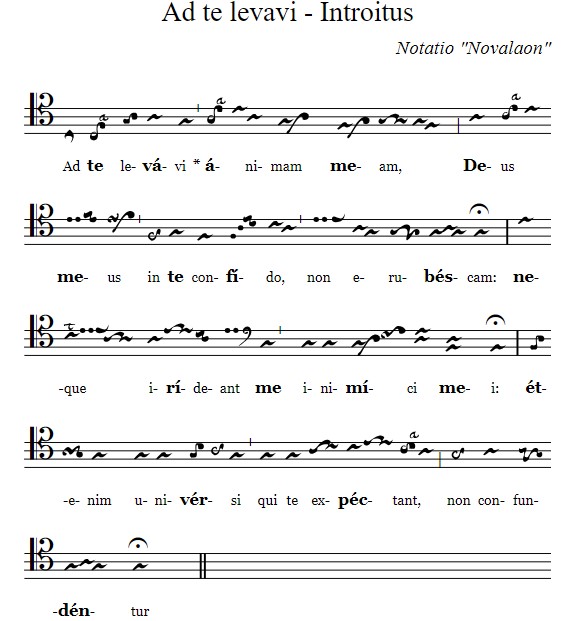
With the last alterations I made I can't see any ambiguous melodic height, to me the notes are clear in terms of pitch.
 test_novalaon.jpg578 x 621 - 72KThanked by 1OMagnumMysterium
test_novalaon.jpg578 x 621 - 72KThanked by 1OMagnumMysterium -
If you are able to read laon fluently it is quite clear, with the distinctions between uncinus and punctum, short clivis X long clivis, short pes X long pes, short torculus x long torculus.
From the novalaon I can sing more fluently differentiating the proportions (short x long, double long and grace notes) than with a triplex edition (either with neumes and square notation or neumes and modern notation) and than modern notation.
I also think novalaon is better than fluxus notation and than lagall notation, and more clean than the edition of Patrick with all those episema.
-
But if you want an equalist interpretation in "classic solesmes" style or Pothier's accentualist style, novalaon is useless
Thanked by 1FSSPmusic -
That most recent novalaon is surprisingly easy for me to read. Really, I am surprised, it looks pretty intimidating. Definitely more elegant than modern notation or Mr. Williams' edition. I'm sure there's some room for a little graphic improvement still, but I think it's definitely the right path. No melodic ambiguity, just a few places I question the rhythm, but that can be remedied by becoming more familiar with the neumes. Of course, a "nueme key" showing the neumes next to the modern notation equivalents would be essential for those who aren't familiar with Laon to learn it.Thanked by 1Lincoln_Hein
-
OMagnumMysterium, In what places you find problem with the rhythm ?
-
OMagnumMysterium, What do you think? Do I place the neumes closer together like this, including the long ones?
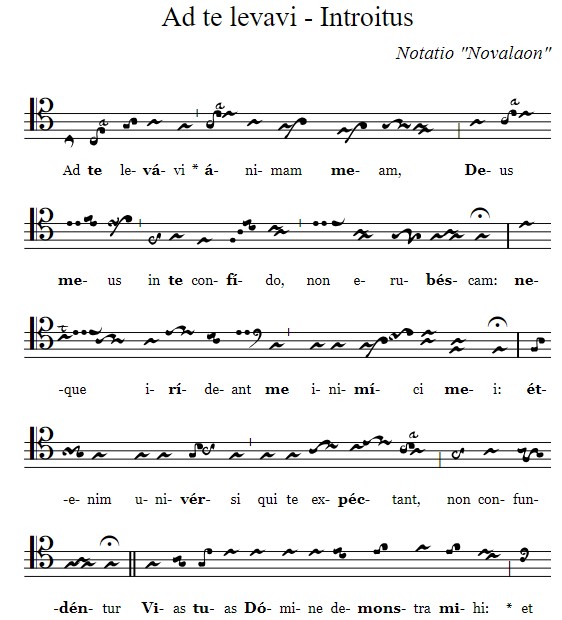
-
Well, it's simply that I only have a moderate familiarity with Laon (which is still more than most people), and I don't spend that much time with the Laon neumes. So for the uninitiated, it is not immediately obvious for every single note whether it is short or long. I can easily remember the difference between a single long and a single short, but for the multi note neumes, I am part examining the shapes, part remembering how Laon works, and part relying on my memory of the rhythm from singing it over the past couple of days.
I think it's pretty good, as long as the neumes are consistent and we have a key to memorize what each of them mean (like how we memorize the symbols for any other form of notation).
I assume that A, T, and the fermata all mean the same thing, the doubling of a note's normal value. I don't understand why the Ti in Neque has a T, since it is already a long note.
I think the graphics could be improved to be slightly more robust without altering the fundamental shape, but that's a finer point of detail which could be worried about later.
In answer to your most resent post, I like the neume spacing better in the former one (the further apart spacing), but maybe something in between the two would be good.Thanked by 1Lincoln_Hein -
the "a" I'm using only to clarify the rhythm of light pes with initio debilis (the high note is equal to an uncinus and the first low note with the curved shape is a grace note before the beat like an acciaccatura). The "t" I only copied and pasted from the original Laon. It can signify in this context to someone a slight agogic lenghtening. The fermata only in the double longs. I could use a horizontal episema (a tenuto) to signify a slight nuance and reserve the "t" for the notes (like some of the Ave Maria offertory) that are long+short in duration, like a modern punctuated note.
The "cursive form and connected" of the neumes indicates in Laon or all notes as breves ou all but the last (wich is long): here I always made the design of the last note similar to an uncinus when the last note is long (with the exception of the pes initio debilis wich is a special case because the first note is shorter than breve).
the virga (as the ones used in the long pes "mam" from "animam" "me" from "meam" "mi" from "inimici") and uncinus are always long and the oriscus if I made connected with a puntum (in "etenim") is short otherwise long (in "meus").Thanked by 1OMagnumMysterium -
Ah, I have no familiarity with Laon notation. I am a mere yeoman singer.
When I think of Laon, the first thing I think of this: https://tinyurl.com/ne6hcyw3 -
Like Fluxus, I find the Novalaon notation interesting and am able to read it without difficulty, but I question what advantages it offers over a duplex or triplex edition—or modern standard round notation. I'm also concerned that it makes the score unnecessarily esoteric instead of more accessible. If someone with a solid musical background must study six years to be considered a semiologist (according to Blackley), how long must one study to become a proportionalist? I fear these kinds of scores increase the study demands and might discourage some very competent singers who would do just fine with modern notation or my editions.
In a number of cases, you will have to "translate" St. Gall or other neumes for chants that are lacking in L. (Stingl has occasionally done something similar in "translating" Messine neumes to St. Gall.) Whether you're going to adhere to the Graduale Novum or the Vatican edition, you have to alter some of the neumes, which you've done in the example above at the first te and again at te exspectant. L doesn't notate the entire psalm verse, but you have written two longs at the mediant cadence, just as I do in my edition, where St. Gall has a short clivis. The added letters are helpful, but I don't think the n at universi should be neglected. The rather rounded initial stroke of the cursive torculus is problematic, as the Messine notation is relatively square there, just as for the pes, and reserves the rounded form for special cases involving ornamental notes. How will you notate the unison epiphonus? How will you notate the descending cephalicus or descending pinnosa? How will you notate the torculus when the third note is short, e.g., in the short pes subbipunctis? I admire all the effort you have clearly put into this! -
OMagnum raises another good point here. There are a lot of redundant letters in L (and others). In this example, you didn't include the t in (ex)spe(ctant), but you did include the a on the next syllable, albeit positioned above the upper note instead of between the notes. If you aim to produce editions that will also satisfy the Cardinian semiologists, inclusion of all letters is a consideration, but it opens other cans of worms too... will you attempt reproduce every slight variation in size and spacing as well? I rather like the fermata, because we immediately know it's editorial. I have used it in some modern notation examples, although not in the Thirteen Offertory Chants.I don't understand why the Ti in Neque has a T, since it is already a long note.
This can also be called clivis quassa.quick clivis beginning in oriscus -
The descending cephalicus I notated in the pdf above in the syllable "et" of psalmody. The pinnosa would be some curved form similar to this but maybe with the extra first note of the torculus. A short pes subbipunctis can be notated exactly as this, "a short pes with two punctis after" or as with a torculus without the third note similar to uncinus and with a third note similar to the last note of the porrectus flexus on "fun"(confundentur). The initial note of the quick torculus can easily be redesigned to more quadratic form and less curved and the torculus initio debilis would be with a design similar to the pes initio debilis. The liquescents and initio debilis basically need some type of spiral like the ones I did on the last note of tristropha on "ant", on the initio debilis in "te" and "animam" and in the epiphonus on "non", it's possible two spirals one to left and other to right in the same figure if it is initio debilis and liquescent simultaneously, and the "a" can be used if you need to differentiate between a long liquescense and a short.Thanked by 1FSSPmusic
-
I developed another type of notation: a compact version of the modern one ("round black" for breves, "round white" for longs and elonganted "round white" for double long) with added ornamental notes (short and long oriscus, quilisma, stropha, initio debilis and liquescents). The liquescent when long is at the same height as the previous note. The design of the initio debilis (with the curve to the right) can be used also in the cases of "grace notes" between notes of the neume in descending passages (inverted quilisma of montpellier).

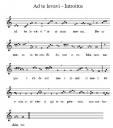
 compact_modern_with_ornaments.jpg537 x 608 - 64K
compact_modern_with_ornaments.jpg537 x 608 - 64K -
With larger notes, do clef and stave with 4 lines:
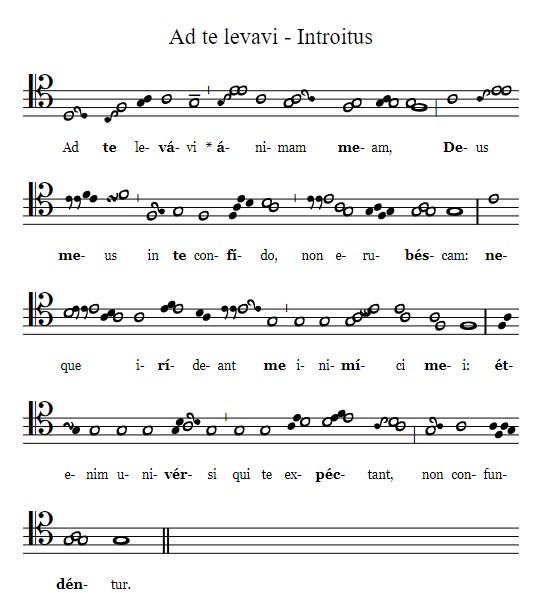

 compact_modern_with_ornaments2.jpg535 x 593 - 65K
compact_modern_with_ornaments2.jpg535 x 593 - 65K -
How about something like this?
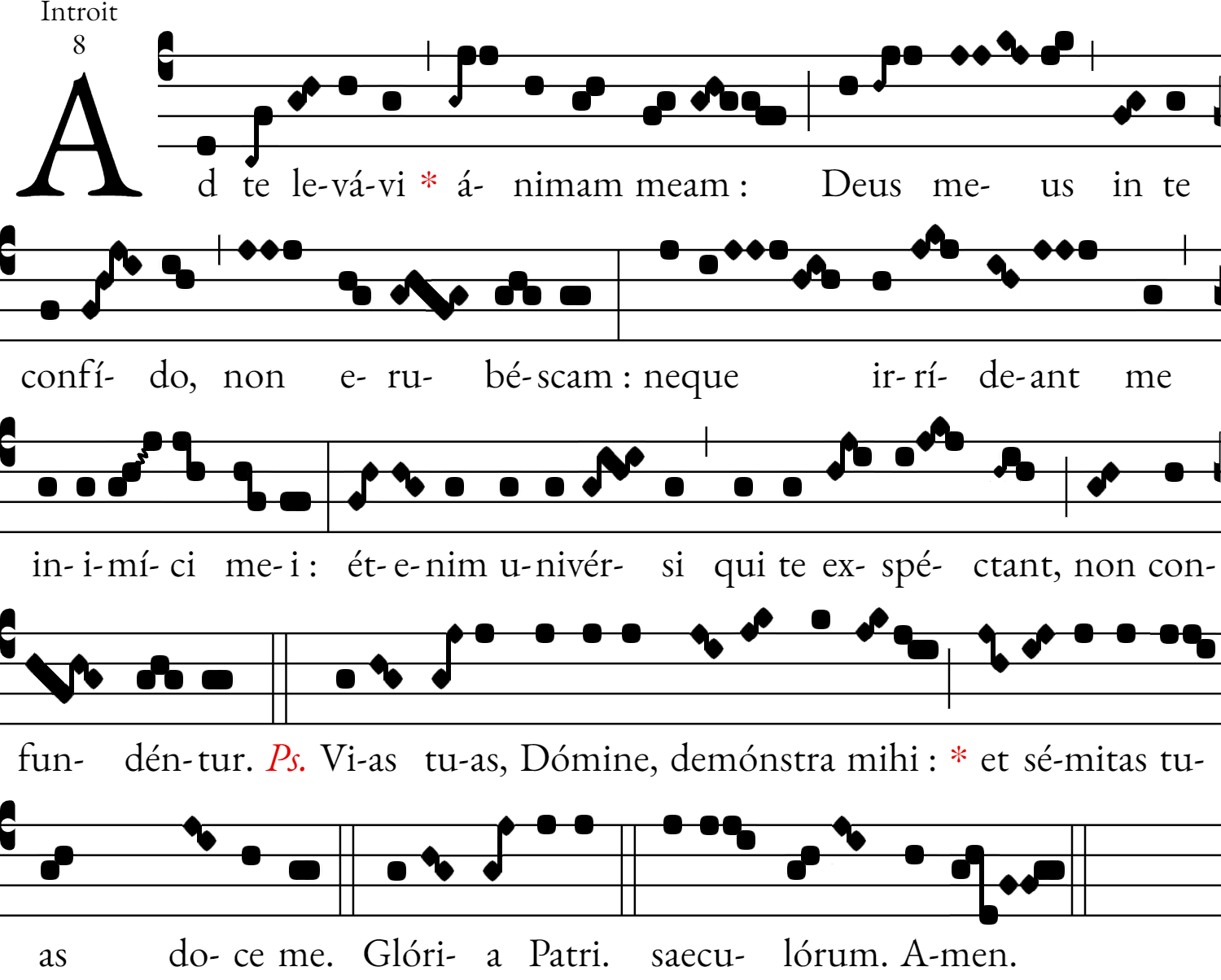

 Ad Te Levavi, notation draft 3.png1500 x 1204 - 147K
Ad Te Levavi, notation draft 3.png1500 x 1204 - 147K -
OmagnumMysterium, this last is great for people who are used to the square notation (but I missed some liquescents and the oriscus). How you did it? It's easy to apply on gregorio tex?
I liked very much the last I did, the compact modern with large black and white rounded notes, ornamental notes, and do clef, for my personal use I think I will make like that.Thanked by 1OMagnumMysterium -
I made it using the paint application, but it could be made to work with gregorio tex using FontForge. Adjusting the gregorio font would take a while for me to work through, but I might do it sometime, or someone better than me at FontForge could do it more quickly.
I didn't include liquescents or oriscus because I don't understand how they work or what they do. Maybe someone can give me a good simple explanation of what information they convey different from the simple long and short notes.
In your last edition above, it would actually seem more intuitive to me for long notes to be filled and short notes hollow, but either way I could get used to it very quickly. Your last edition is quite easy to read. Although it's not my favorite aesthetically, it works, and I think it is the best round note edition I have seen. I would need an explanation of what is going on with the hook notes though. Liquescents I assume?
Welcome to the MusicaSacra Forum!
To participate in the discussions on Catholic church music, sign in or register as a forum member, The forum is a project of the Church Music Association of America.
Categories
- All Discussions21,096
- General Music Discussion8,211
- Job Openings197
- Management of Music Programs850
- Choral Matters532
- Church Documents and Rubrics524
- CMAA Notes301
- Events716
- For Newcomers: Read First26
- Sacred Polyphony546
- Hymnody872
- Gregorian Chant: General2,697
- ↳ Graduale Romanum and Liber Usualis368
- ↳ Graduale Simplex60
- ↳ Semiology63
- Vernacular Plainsong696
- Anglican Use and Anglican Chant68
- Organ, Other Instruments and Repertoire435
- New Composition/Works in Progress1,290
- Recordings230
- Music for Hispanic Ministry159
- Music Education: Children211
- Music Education: General222
- News Items245
- Positions Wanted2
- General Discussion: Catholicism739
- Amusements177
- General Discussion1,033
- Opinions117

